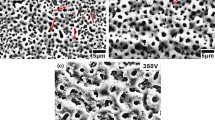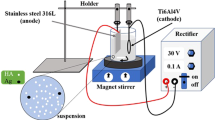Abstract
Composite coatings with the variable contents of Sr substituted for Ca in hydroxyapatite (HA) were prepared on the surface of Ti13Nb13Zr alloy by the combination of microarc oxidation (MAO) and hydrothermal treatment (HT). The experimental results show the obvious rod-like HA/Sr–HA crystals in the MAO–HT coatings with various Sr contents. A good hydrophilicity is presented in all surfaces after the MAO–HT treatment and especially in the 40-Sr sample with superhydrophilicity. The coating surfaces with various Sr contents show different degrees of apatite coverage by SBF immersion experiment and also showing the best in the 40-Sr sample. The apatite induction ability of the coatings can be effectively improved by adding Sr. However, the effect of Sr contents on apatite induction is limited. The apatite induction ability is decreased and even inhibited when the Sr doping exceeds 70%.
Graphical abstract
The surface morphology of the 40-Sr sample of (a) MAO, (b) MAO–HT, (C) immersing in SBF after 10 days, and (c) the percentage of Ca and P elements in MAO–HT coatings with various Sr contents after 10 days of immersion in SBF.
Among the hydroxyapatite coatings with the variable contents of Sr substituted for Ca prepared by the combination of microarc oxidation and hydrothermal treatment, the 40-Sr sample has the best apatite induction ability.










Similar content being viewed by others
Data availability
The datasets generated during and/or analyzed during the current study are available from the corresponding author on reasonable request.
References
C.H. Huang, M. Yoshimura, Direct ceramic coating of calcium phosphate doped with strontium via reactive growing integration layer method on alpha-Ti alloy. Sci. Rep. 10(1), 10602 (2020)
N. Huebsch, D.J. Mooney, Inspiration and application in the evolution of biomaterials. Nature 462(7272), 426–432 (2009)
T.W. Xu, S.S. Zhang, S. Liang, N. Cui, L. Cao, Y. Wan, Precipitation behaviour during the beta → alpha/omega phase transformation and its effect on the mechanical performance of a Ti–15Mo–2.7Nb–3Al–0.2Si alloy. Sci. Rep. 9(1), 17628 (2019)
T.W. Xu, S.S. Zhang, F.S. Zhang, H.C. Kou, J.S. Li, Effect of ω-assisted precipitation on β → α transformation and tensile properties of Ti–15Mo–2.7Nb–3Al–0.2Si alloy. Mater. Sci. Eng. A 654, 249–255 (2016)
M. Kaur, K. Singh, Review on titanium and titanium based alloys as biomaterials for orthopaedic applications. Mater. Sci. Eng. C 102, 844–862 (2019)
R. Bobbili, V. Madhu, Dynamic recrystallization behavior of a biomedical Ti–13Nb–13Zr alloy. J. Mech. Behav. Biomed. Mater. 59, 146–155 (2016)
M. Jażdżewska, B. Majkowska-Marzec, Hydroxyapatite deposition on the laser modified Ti13Nb13Zr alloy. Adv. Mater. Sci. 17(4), 5–13 (2017)
M. Supernak-Marczewska, A. Ossowska, P. Strąkowska, A. Zieliński, Nanotubular oxide layers and hydroxyapatite coatings on porous titanium alloy Ti13Nb13Zr. Adv. Mater. Sci. 18(4), 17–23 (2018)
A.L. Ribeiro, P. Hammer, L.G. Vaz, L.A. Rocha, Are new TiNbZr alloys potential substitutes of the Ti6Al4V alloy for dental applications? An electrochemical corrosion study. Biomed. Mater. 8(6), 065005 (2013)
N. Diomidis, S. Mischler, N.S. More, M. Roy, S.N. Paul, Fretting-corrosion behavior of β titanium alloys in simulated synovial fluid. Wear 271(7–8), 1093–1102 (2011)
J. Wang, Y. Pan, R. Feng, H. Cui, B. Gong, L. Zhang, Z. Gao, X. Cui, H. Zhang, Z. Jia, Effect of electrolyte composition on the microstructure and bio-corrosion behavior of micro-arc oxidized coatings on biomedical Ti6Al4V alloy. J. Mater. Res. Technol. 9(2), 1477–1490 (2020)
S. Lederer, P. Lutz, W. Fürbeth, Surface modification of Ti13Nb13Zr by plasma electrolytic oxidation. Surf. Coat. Technol. 335, 62–71 (2018)
L. Cao, I. Ullah, N. Li, S. Niu, R. Sun, D. Xia, R. Yang, X. Zhang, Plasma spray of biofunctional (Mg, Sr)-substituted hydroxyapatite coatings for titanium alloy implants. J. Mater. Sci. Technol. 35(5), 719–726 (2019)
P. Bansal, G. Singh, H.S. Sidhu, Plasma-sprayed HA/Sr reinforced coating for improved corrosion resistance and surface properties of Ti13Nb13Zr titanium alloy for biomedical implants. J. Mater. Res. 36(2), 431–442 (2021)
R. Luo, Z. Liu, F. Yan, Y. Kong, Y. Zhang, The biocompatibility of hydroxyapatite film deposition on micro-arc oxidation Ti6Al4V alloy. Appl. Surf. Sci. 266, 57–61 (2013)
H. Lee, M.Y. Song, J. Jurng, Y.-K. Park, The synthesis and coating process of TiO2 nanoparticles using CVD process. Powder Technol. 214(1), 64–68 (2011)
E. Yılmaz, Modification of the micro arc-oxidized Ti surface for implant applications. J. Bionic Eng. 18(6), 1391–1399 (2021)
T.W. Clyne, S.C. Troughton, A review of recent work on discharge characteristics during plasma electrolytic oxidation of various metals. Int. Mater. Rev. 64(3), 127–162 (2018)
R. Zhou, D. Wei, J. Cao, W. Feng, S. Cheng, Q. Du, B. Li, Y. Wang, D. Jia, Y. Zhou, Effect of heat treatment atmosphere on the structure and apatite-inducing ability of Ca, P, Si and Na incorporated microarc oxidation coating on titanium. Surf. Coat. Technol. 310, 190–198 (2017)
K. Rokosz, T. Hryniewicz, S. Raaen, P. Chapon, Investigation of porous coatings obtained on Ti–Nb–Zr–Sn alloy biomaterial by plasma electrolytic oxidation: characterisation and modelling. Int. J. Adv. Manuf. Technol. 87(9–12), 3497–3512 (2016)
A. Kazek-Kesik, G. Dercz, I. Kalemba, K. Suchanek, A.I. Kukharenko, D.M. Korotin, J. Michalska, A. Krzakala, J. Piotrowski, E.Z. Kurmaev, S.O. Cholakh, W. Simka, Surface characterisation of Ti–15Mo alloy modified by a PEO process in various suspensions. Mater. Sci. Eng. C 39, 259–272 (2014)
S. Durdu, Ö.F. Deniz, I. Kutbay, M. Usta, Characterization and formation of hydroxyapatite on Ti6Al4V coated by plasma electrolytic oxidation. J. Alloys Compd. 551, 422–429 (2013)
H. Zhou, J. Lee, Nanoscale hydroxyapatite particles for bone tissue engineering. Acta Biomater. 7(7), 2769–2781 (2011)
Y. Tsutsumi, M. Niinomi, M. Nakai, H. Tsutsumi, H. Doi, N. Nomura, T. Hanawa, Micro-arc oxidation treatment to improve the hard-tissue compatibility of Ti–29Nb–13Ta–4.6Zr alloy. Appl. Surf. Sci. 262, 34–38 (2012)
M. Montazeri, C. Dehghanian, M. Shokouhfar, A. Baradaran, Investigation of the voltage and time effects on the formation of hydroxyapatite-containing titania prepared by plasma electrolytic oxidation on Ti–6Al–4V alloy and its corrosion behavior. Appl. Surf. Sci. 257(16), 7268–7275 (2011)
P. Xiu, Z. Jia, J. Lv, C. Yin, Y. Cheng, K. Zhang, C. Song, H. Leng, Y. Zheng, H. Cai, Z. Liu, Tailored surface treatment of 3D printed porous Ti6Al4V by microarc oxidation for enhanced osseointegration via optimized bone in-growth patterns and interlocked bone/implant interface. ACS Appl. Mater. Interfaces 8(28), 17964–17975 (2016)
H.-J. Song, K.-H. Shin, M.-S. Kook, H.-K. Oh, Y.-J. Park, Effects of the electric conditions of AC-type microarc oxidation and hydrothermal treatment solution on the characteristics of hydroxyapatite formed on titanium. Surf. Coat. Technol. 204(14), 2273–2278 (2010)
M. Fazel, H.R. Salimijazi, M. Shamanian, I. Apachitei, A.A. Zadpoor, Influence of hydrothermal treatment on the surface characteristics and electrochemical behavior of Ti–6Al–4V bio-functionalized through plasma electrolytic oxidation. Surf. Coat. Technol. 374, 222–231 (2019)
J. Zhou, Y. Han, Effect of hydrothermal treatment model on the formation of Sr–HA nanorod arrays on microarc oxidized titania coatings. Appl. Surf. Sci. 286, 384–390 (2013)
J. Zhou, B. Li, Y. Han, L. Zhao, The osteogenic capacity of biomimetic hierarchical micropore/nanorod-patterned Sr–HA coatings with different interrod spacings. Nanomedicine 12(5), 1161–1173 (2016)
Y. Li, Q. Li, S. Zhu, E. Luo, J. Li, G. Feng, Y. Liao, J. Hu, The effect of strontium-substituted hydroxyapatite coating on implant fixation in ovariectomized rats. Biomaterials 31(34), 9006–9014 (2010)
J. Zhou, J. Shao, Y. Han, Effect of hydrothermal treatment model on stability and bioactivity of microarc oxidized titania coatings. Appl. Surf. Sci. 303, 367–372 (2014)
C. Capuccini, P. Torricelli, E. Boanini, M. Gazzano, R. Giardino, A. Bigi, Interaction of Sr-doped hydroxyapatite nanocrystals with osteoclast and osteoblast-like cells. J. Biomed. Mater. Res. A 89(3), 594–600 (2009)
R. Schmidt, A. Gebert, M. Schumacher, V. Hoffmann, A. Voss, S. Pilz, M. Uhlemann, A. Lode, M. Gelinsky, Electrodeposition of Sr-substituted hydroxyapatite on low modulus beta-type Ti–45Nb and effect on in vitro Sr release and cell response. Mater. Sci. Eng. C 108, 110425 (2020)
G. Wu, Y. Wang, M. Sun, Q. Zhang, J. Yao, Influence of microstructure of TC4 substrate on the MAO coating. Surf. Eng. 36, 1–10 (2019)
Y. Wang, H. Yu, C. Chen, Z. Zhao, Review of the biocompatibility of micro-arc oxidation coated titanium alloys. Mater. Des. 85, 640–652 (2015)
L.Z. Chen, W. Li, Invariable current mode microarc oxidation on titanium surface and its energy. Rare Met. Mater. Eng. 37(4), 682–685 (2008)
C.J. Chung, H.Y. Long, Systematic strontium substitution in hydroxyapatite coatings on titanium via micro-arc treatment and their osteoblast/osteoclast responses. Acta Biomater. 7(11), 4081–4087 (2011)
K. Lin, P. Liu, L. Wei, Z. Zou, W. Zhang, Y. Qian, Y. Shen, J. Chang, Strontium substituted hydroxyapatite porous microspheres: surfactant-free hydrothermal synthesis, enhanced biological response and sustained drug release. Chem. Eng. J. 222, 49–59 (2013)
D.-P. Zhao, W. Shi, P. Shang, H.-M. Nie, Y. Zhang, J.-C. Tang, Effects of Sr incorporation on surface structure and corrosion resistance of hydroxyapatite coated Mg–4Zn alloy for biomedical applications. Trans. Nonferr. Met. Soc. China 28(8), 1563–1570 (2018)
A. Kazek-Kesik, K. Kuna, W. Dec, M. Widziolek, G. Tylko, A.M. Osyczka, W. Simka, In vitro bioactivity investigations of Ti–15Mo alloy after electrochemical surface modification. J. Biomed. Mater. Res. B 104(5), 903–913 (2016)
X. Rao, C.L. Chu, Q. Sun, Y.Y. Zheng, Fabrication and apatite inducing ability of different porous titania structures by PEO treatment. Mater. Sci. Eng. C 66, 297–305 (2016)
X. Liu, Y. Miao, H. Liang, J. Diao, L. Hao, Z. Shi, N. Zhao, Y. Wang, 3D-printed bioactive ceramic scaffolds with biomimetic micro/nano-HAp surfaces mediated cell fate and promoted bone augmentation of the bone–implant interface in vivo. Bioact. Mater. 12, 120–132 (2022)
Acknowledgments
This work was co-supported by Shandong Provincial Natural Science Foundation (No. ZR2020ME006) and the Key Research and Development Program of Shandong Province of China (No. 2018GGX102027).
Author information
Authors and Affiliations
Contributions
YCL contributed toward writing of the original draft and data curation. TWX contributed toward conceptualization, methodology, and writing, reviewing, and editing of the manuscript. BQS contributed toward writing, reviewing, and editing of the manuscript. BJL contributed toward methodology. HW contributed toward investigation.
Corresponding author
Ethics declarations
Conflict of interest
The authors declare that they have no known competing financial interests or personal relationships that could have appeared to influence the work reported in this paper.
Rights and permissions
About this article
Cite this article
Liu, Y.C., Xu, T.W., Sun, B.Q. et al. Effect of strontium-doped coating prepared by microarc oxidation and hydrothermal treatment on apatite induction ability of Ti13Nb13Zr alloy in vitro. Journal of Materials Research 37, 2675–2685 (2022). https://doi.org/10.1557/s43578-022-00626-x
Received:
Accepted:
Published:
Issue Date:
DOI: https://doi.org/10.1557/s43578-022-00626-x




